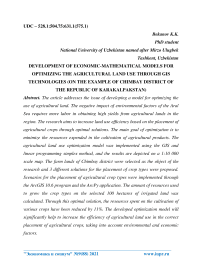Development of economic-mathematical models for optimizing the agricultural land use through GIS technologies (on the example of Chimbay district of the Republic of Karakalpakstan)
Автор: Bekanov K.K.
Журнал: Экономика и социум @ekonomika-socium
Рубрика: Основной раздел
Статья в выпуске: 9 (88), 2021 года.
Бесплатный доступ
The article addresses the issue of developing a model for optimizing the use of agricultural land. The negative impact of environmental factors of the Aral Sea requires more labor in obtaining high yields from agricultural lands in the region. The research aims to increase land use efficiency based on the placement of agricultural crops through optimal solutions. The main goal of optimization is to minimize the resources expended in the cultivation of agricultural products. The agricultural land use optimization model was implemented using the GIS and linear programming simplex method, and the results are depicted on a 1:10 000 scale map. The farm lands of Chimbay district were selected as the object of the research and 3 different solutions for the placement of crop types were proposed. Scenarios for the placement of agricultural crop types were implemented through the ArcGIS 10.6 program and the ArcPy application. The amount of resources used to grow the crop types on the selected 100 hectares of irrigated land was calculated. Through this optimal solution, the resources spent on the cultivation of various crops have been reduced by 11%. The developed optimization model will significantly help to increase the efficiency of agricultural land use in the correct placement of agricultural crops, taking into account environmental and economic factors.
Agricultural land use, land use optimization, GIS technologies, irrigated land, crop types
Короткий адрес: https://sciup.org/140254887
IDR: 140254887
Список литературы Development of economic-mathematical models for optimizing the agricultural land use through GIS technologies (on the example of Chimbay district of the Republic of Karakalpakstan)
- Alexander Herzig, 2008, A GIS-based Module for the Multiobjective Optimization of Areal Resource Allocation, 11th AGILE International Conference on Geographic Information Science, 1-17.
- Aravossis, K., Brebbia, C.A., Kakaras, E. and Kungolos A.G., 2006, Environmental Economics and Investment Analysis, Southampton, England: WIT Press.
- AGRAWAL, R.C. and E.O. HEADY (1972): Operations Research Methods for Agricultural Decisions. Iowa State University Press, Iowa.
- Bekanov, K. et al., 2020, Creating land use/land cover map using methods GIS and remote sensing (on the example the Chimbay district of the Karakalpakstan republic), International Journal of Pharmaceutical Research. Vol. 12, Iss. 3.
- Chuvieco, E., 1993, Integration of linear programming and GIS for land-use modelling, International Journal of Geographical Information Systems, 7(1), 71–83, doi:10.1080/02693799308901940.
- Djanibekov, N., Sommer, R., & Djanibekov, U., 2013, Evaluation of effects of cotton policy changes on land and water use in Uzbekistan: Application of a bio-economic farm model at the level of a water users’ association, Agricultural Systems, 118, 1–13. doi:10.1016/j.agsy.
- Galán-Martín, Á. P. G., 2015, Multi-stage linear programming model for optimizing cropping plan decisions under the new Common Agricultural Policy, Land Use Policy. 48, 515–524.
- Galán-Martín, Á., Pozo, C., Guillén-Gosálbez, G., Antón Vallejo, A., & Jiménez Esteller, L., 2015, Multi-stage linear programming model for optimizing cropping plan decisions under the new Common Agricultural Policy, Land Use Policy, 48, 515–524. doi:10.1016/j.landusepol.
- Jain, P., and Ramsankaran, R., 2019, GIS-based Integrated Multi-Criteria Modelling Framework for Watershed Prioritisation in India—A Demonstration in Marol Watershed, Journal of Hydrology, 124131, doi:10.1016/j.jhydrol.2019.124131.
- Jeffrey, L. Arthur and Darek, J. Nalle, 1997, Clarification on the use of linear programming and GIS for land-use modelling, int. j. geographical information science, vol. 11, no. 4, 397±402.
- Kholmurzaev, I. et al., 2016, Qishloq xo'jalik mahsulotlarini yetishtirishda talab etiladigan mehnat va moddiy resurslar sarfi me'yorlari, Tashkent, 9-37.
- Olshevskiy, A.V. Yatsukhno, V.M. 2010, Optimizatsia agrarnogo zemlepolzovaniya na landshaftnoy osnove s ispolzovaniem GIS-tehnologiy (na primere Belorusskogo polesya), Nature management: ecology, economics, technology, Materials of the International Scientific Conference, Minsk, October 6-8, 231-238.
- Papalambros, P.Y. and Wilde, D.J., 2000, Principles of optimal design: modeling and computation, 2nd edition, (http://www.optimaldesign.org/), Cambridge: Cambridge University Press.
- Reimov, P., and Fayzieva, D., 2014, The Present State of the South Aral Sea Area, In Micklin, P., Aladin, N.V. and Plotnikov, I., (Eds.), The Aral Sea, 171–206.
- Safarov, E. et al., 2020, Application of geoinformation technologies and remote sensing to detect land use and changes in the soil cover caused by the drying of the Aral Sea. Periódico Tchê Química. ISSN 2179-0302. vol.17 (n°36).
- Turdimambetov I., Madreymov, A., Foldvary L., Oteuliev M., Kurbanov, V., Utarbaeva, K., Bekanov, K., 2021, Influence of Adverse Ecological Factors on the Incidence of Malignant Neoplasms, E3S Web of Conferences, Volume 227, https://doi.org/10.1051/e3sconf/202122702001.
- Valeriy Alakoz, 2015, Sistema optimizatsii selskohozyaystvennogo zemlepolzovaniya, Zemelnie otnosheniya i zemleustroystvo, 3-8p.


